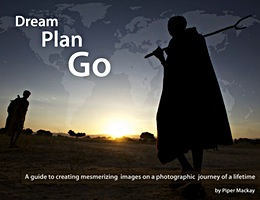
The background in your photo is crucial in making a powerful, successful image. You can have an exotic subject, an intense emotional connection, and stunning light, but if you have forgotten to look at your background, chances are the photograph becomes just a snapshot of something you found interesting. It’s just one of the essential elements that we focus on in the Spirit-N-Light workshops. What I tell my participants is that if you have picked up your camera, I am assuming whatever you are pointing it at is a subject you find to be exotic, even if it was a rock. Therefore, you don’t need to think about your subject, and it is a given that your subject is spectacular; don’t even think about raising your camera until you have quickly evaluate the scene and asked yourself, “What is my background?” followed by, “what is my light?” It’s sounds easy enough and part of the basics of photography, but when human excitement and emotion are involved it is amazing how quickly these critical elements are forgotten.
Throughout the year, I travel with many very talented photographers, to some of the most exotic photographic locations in the world. Without fail, I watch them become so excited the first time they see a beautiful tribal person or striking leopard, that they throw up their camera’s and start to fire without any thought to the composition. It would be ok if it were a quick natural response, but I found many photographers stay in this zone for several days, if not the entire trip. They are so captivated and overwhelmed by the experience or concentrating too much on the subject that they are not able to separate that emotion to make a powerful and successful image. You see hundreds of snapshots flooding the Internet all taken in exotic locations, but there are only a few that grab your attention. These are the photographers that have learned to see quickly through their subject and focus on the background and light before they click.
Backgrounds should compliment or empower your subject. If you have sweeping views in your background, they should be telling a story about your subject, giving a sense of place to your subject, or be just as dramatic as your subject. If you are a taking a tightly framed portrait, your goal should be to have a soft blurred out background, like a backdrop in a portrait studio. Like all things in life, even the simple things take practice. It is much better to spend a few solid days, practicing a critical element of photography and honing in on your skills in your backyard, before jumping into an expensive photographic destination than returning home disappointed. It’s probably the biggest difference I see when reviewing my participant’s images on the road; those who have invested time in their craft outside of their travels produce higher quality images. I highly urge all of you who wish to capture those jaw-dropping award-winning images, practice, practice, practice before you head off to that exotic destination.
Below are some examples of how one simple change, can make a powerful difference.
In the first image the background is very distracting. The bright light in the background grabs the viewer attention rather than the subject whom I found fascinating. By simply putting up a skin, I have eliminated the distracting background enhancing and enhancing my subject, which makes a much stronger portrait.
In the first image I was careful to watch my frame, not clipping the feet or the shadow, but I didn’t look beyond my subject to see that the background was interfering with the viewers connection to my subject. In the second image I simply took a step to the left and used the trees for leading lines to my subject. There are no distractions behind my subject, creating a much stronger image and emotional connection to the subject.
In the first image the horizon is running right through the head and eyes of my subject. I usually always try to keep the horizons below the shoulders, even with wildlife. In the second image I simply got down a little lower to drop the horizon and create a stronger photograph.
When looking at the image below I would immediately think this was the first time someone is seeing a lion and they just throw up their camera in excitement and took a snap shoot. Especially when photographing wildlife it is important to predict the animals behavior and be able to line up the vehicle for the best light and background. The second image is much more appealing; the lions are dropped into the lower part of the frame, the kopjis and acacia tree do not interfere with the subject and they give you the hint that it was taken in the Serengeti and it is set against an interesting sky. In the last image it was the dramatic sky that had my attention. A few of the other members of this pride had already come down from the kopjis and I predicted these females would follow. I had only a few seconds to click the shutter. Had I not been in position, I would have missed the shot.
The first time you are with a huge group of Galada’s it is very exciting and too easy to just start firing way, creating a lot of time deleting in post production. I would rather focus on a few in good light, with a dramatic background, and create a more powerful image. Just like with people, when making tight portraits I am always look to put them on a soft, blurred out background with no distractions.
Below are just a few techniques we working in the Spirit-N-Light workshop; putting motion in to your still image, using dramatic natural lighting, and focusing on your backgrounds. Practicing you skills before going to an exotic destination will make a huge difference in the quality of images you capture.






















Great advice on composition Piper and exceptional photos. Thanks, Larry
Thank you Larry and you completely understand when I am talking about getting excited seeing very exotic subjects!
Thanks for the article Piper and showing us, not just telling us exactly what you mean. Amazing how just changing your position and taking the time makes all the difference. Love it! One day I will be on an adventure with you…
You are most welcome Terry. In most images, it is usually one simple thing that could have made it great. Practice often and it should become second nature. I would love to have you on an adventure some day!
Great tips Piper! I am more aware of background now but am still guilty of hurrying shots and have a ways to go to get it right. I don’t usually have poles or trees sticking out of peoples’ heads anymore so that’s a good thing;-)
Keep up the great work and thanks for those tips!
Sandy
Thanks Sandy, but you have been positing some outstanding images lately!!
nicely written, Piper! Hope you’re well.
Allan
insta: allankligerphotography
Allen, things are going great thank you!! Maybe I will see you in Africa soon?!
Extremely wise words Piper. Every aspiring photographer should cherish and remember these lessons.
And yes, excellent photographs – they make compelling examples.
Thank you Gurunath! I am currently on safari with a great group of people and we have been referring back to this post often. Especially in out her on safari, this information about watching you background makes or breaks your image!!
Piper – great article with wonderful examples. I am so looking forward to putting these teachings into practice with you at the Spirit ‘n Light workshop next March.